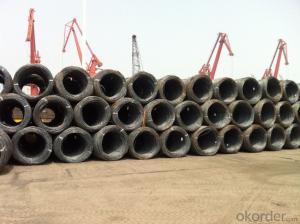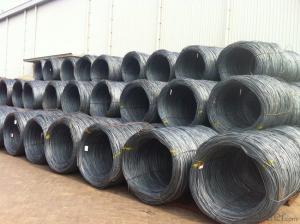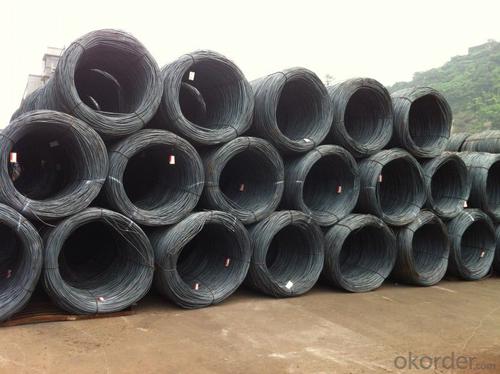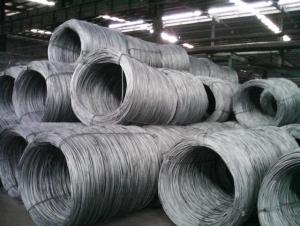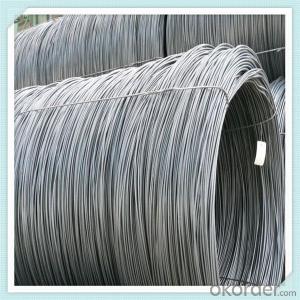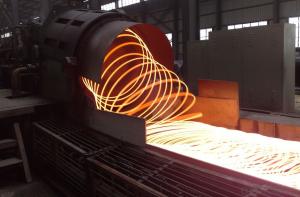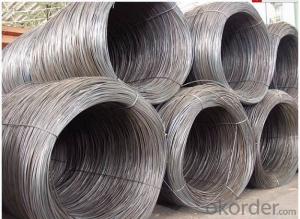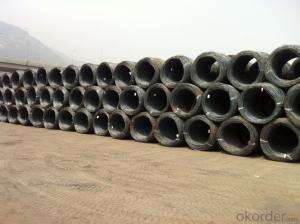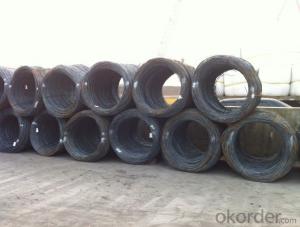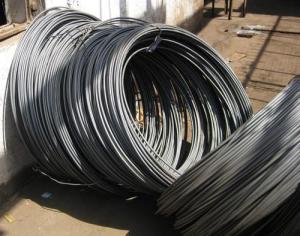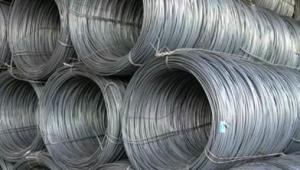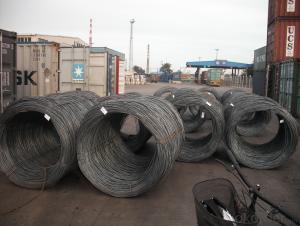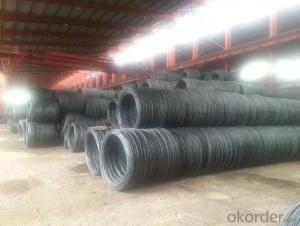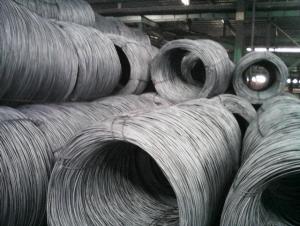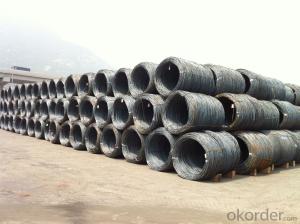SAE 1006-1018 Wire Rods with Best price and Great Quality
- Loading Port:
- Tianjin
- Payment Terms:
- TT OR LC
- Min Order Qty:
- 25 m.t.
- Supply Capability:
- 10000 m.t./month
OKorder Service Pledge
OKorder Financial Service
You Might Also Like
Product Description:
OKorder is offering high quality products at great prices with worldwide shipping. Our supplier is a world-class manufacturer of steel, with our products utilized the world over. OKorder annually supplies products to European, North American and Asian markets. We provide quotations within 24 hours of receiving an inquiry and guarantee competitive prices.
Product Applications:
After hot-rolled the products shaped into coil and delivery as finished product, including round, square, rectangular, hexagonal and so on, Since most of the products are round, it is generally called wire rod. Steel wire rod is widely used in construction and manufacturing. Steel wire rod is mainly used for reinforcement of reinforced concrete and welded structure or reprocessed (roberts, nail etc) materials, especially used to produce wire drawing, welding electrode, nails,spring, electronic, precise machinery parts and so on.
Product Advantages:
OKorder's wire rods are durable, strong, and resist corrosion.
Main Product Features:
· Premium quality
· Prompt delivery & seaworthy packing (30 days after receiving deposit)
· Corrosion resistance
· Can be recycled and reused
· Mill test certification
· Professional Service
· Competitive pricing
Product Specifications:
Manufacture: Hot rolled
Grade: SAE1006-1018
Certificates: ISO, SGS, BV, CIQ
Packaging: Export packing, nude packing, In Coils
Grade | Chemical Composition (%) | |||||
C | Mn | S | P | Si | B | |
SAE1006B | 0.03~O.07 | 0.32max | 0.045max | 0.040max | 0.30max | 0.0008min |
Mechanical properties | ||||||
Yield strength(N/mm2) | Tensile strength(N/mm2) | Elongation (%) | ||||
250-280 | 350-380 | ≥32 | ||||
Grade | Chemical Composition (%) | |||||
C | Mn | S | P | Si | B | |
SAE1008B | 0.10max | 0.3~0.50 | 0.050max | 0.040 max | 0.15max | 0.0008 min |
Mechanical properties | ||||||
Yield strength(N/mm2) | Tensile strength(N/mm2) | Elongation (%) | ||||
≥195 | 315-430 | ≥30 | ||||
FAQ:
Q1: Why buy Materials & Equipment from OKorder.com?
A1: All products offered byOKorder.com are carefully selected from China's most reliable manufacturing enterprises. Through its ISO certifications, OKorder.com adheres to the highest standards and a commitment to supply chain safety and customer satisfaction.
Q2: How do we guarantee the quality of our products?
A2: We have established an advanced quality management system which conducts strict quality tests at every step, from raw materials to the final product. At the same time, we provide extensive follow-up service assurances as required.
Q3: Do you have advantages on payment terms ?
A3: We can accept irrevocable LC at 90/120/180 days .
Images:
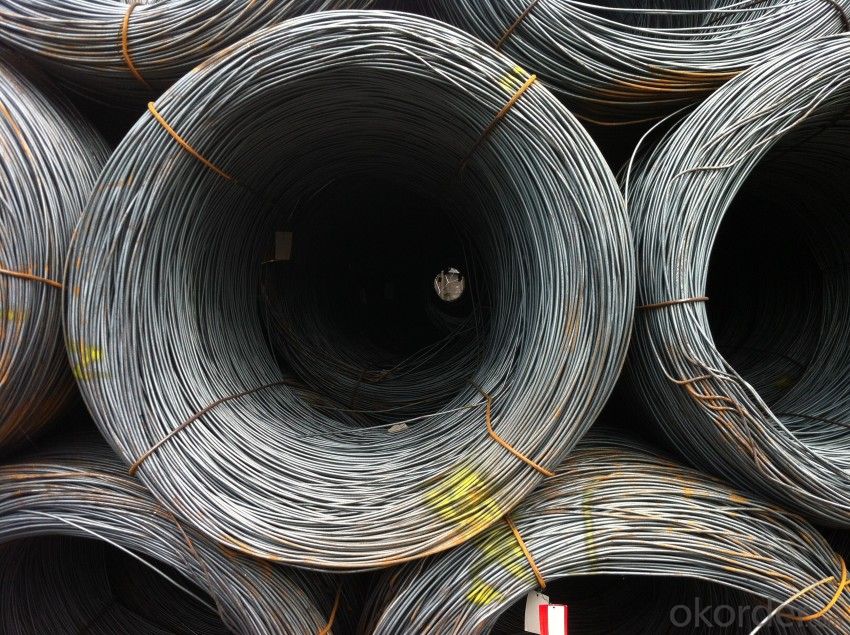

- Q: What are the common defects that can occur during the processing of steel wire rod?
- During the processing of steel wire rod, various defects can arise, impacting the wire rod's properties and performance. Identifying and addressing these defects is of utmost importance. 1. Surface defects, such as scratches, pits, cracks, and scale, can significantly affect the wire rod's appearance and quality. These defects occur due to mishandling, improper rolling, or cooling processes. 2. Internal defects encompass inclusions, voids, and segregation. Inclusions refer to non-metallic particles or impurities weakening the wire rod. Voids are internal cavities that compromise its strength and structural integrity. Segregation involves uneven distribution of alloying elements, resulting in inconsistent mechanical properties along the wire rod's length. 3. Dimensional defects include variations in diameter, ovality, and straightness. These defects occur due to inadequate rolling, cooling, or handling processes, resulting in wire rods that fail to meet required specifications. 4. Decarburization is the loss of carbon from the wire rod's surface during heating or annealing processes. This loss diminishes its strength and hardness, impacting performance in applications requiring high strength. 5. Surface contamination can transpire during the processing of steel wire rod, resulting in foreign materials like oil, grease, dirt, or oxide scales. These contaminants adversely affect the wire rod's surface quality and may cause issues during subsequent processing or applications. To minimize these defects, implementing proper quality control measures throughout the production process is crucial. This involves using high-quality raw materials, employing effective rolling and heat treatment processes, and conducting regular inspections and testing to promptly identify and rectify any defects that arise.
- Q: How is steel wire rod used in the manufacturing of wire for automotive exhaust systems?
- The manufacturing process of wire for automotive exhaust systems heavily relies on steel wire rod. This raw material is vital in producing top-grade wire used in these systems. Initially, steel wire rod goes through a series of procedures to convert it into wire suitable for automotive exhaust systems. The rod is heated first and then passed through rolling mills to decrease its diameter and increase its length. This hot rolling process guarantees that the wire rod achieves the desired dimensions and mechanical properties. Once the wire rod has been rolled to the desired size, it receives further processing. This may involve surface treatment, such as pickling or coating, to enhance its resistance to corrosion and durability. Additionally, the wire may experience specialized heat treatments, like annealing or quenching, to enhance its strength and flexibility. After these treatments, the wire is prepared for use in the manufacturing of automotive exhaust systems. It is typically shaped and configured intricately to fit specific exhaust components, such as catalytic converters, mufflers, or exhaust pipes. The wire is meticulously bent, coiled, or woven to achieve the desired shape and ensure a secure fit within the exhaust system. The wire plays a crucial role in the overall performance of automotive exhaust systems. It serves various purposes, including providing structural support, reducing vibration and noise, and facilitating the flow of exhaust gases. The durability and strength offered by steel wire rod ensure that the wire can withstand the harsh conditions of the exhaust system, including high temperatures, corrosive gases, and mechanical stresses. In conclusion, steel wire rod is a fundamental material used in the manufacturing of wire for automotive exhaust systems. Through a series of processing steps, the wire rod is transformed into high-quality wire that is used to create intricate shapes and configurations for exhaust components. The strength, durability, and corrosion resistance of the wire guarantee optimal performance of the exhaust system, contributing to the overall efficiency and longevity of the vehicle.
- Q: What are the common production processes for carbon-coated steel wire rod?
- The common production processes for carbon-coated steel wire rod include wire drawing, cleaning, coating, and curing. Wire drawing involves pulling the steel wire rod through a series of dies to reduce its diameter. After wire drawing, the wire is cleaned to remove any impurities or contaminants. Next, the wire is coated with a layer of carbon, which can be done through various methods such as electroplating or hot-dip coating. Finally, the coated wire is cured, usually through a heat treatment process, to ensure the carbon coating adheres firmly to the steel wire rod.
- Q: What are the different types of wire mesh for sieving made from steel wire rod?
- The different types of wire mesh for sieving made from steel wire rod include plain weave mesh, twill weave mesh, and dutch weave mesh. Plain weave mesh is the simplest and most common type, with evenly spaced wires in both the warp and weft directions. Twill weave mesh has a diagonal pattern, providing increased strength and durability. Dutch weave mesh has smaller openings in the weft direction, making it ideal for fine sieving applications.
- Q: What are the common heat treatment processes for steel wire rod?
- Steel wire rods undergo various heat treatment processes to enhance their properties and characteristics. These processes, including annealing, quenching, tempering, and normalizing, serve specific purposes. 1. Annealing involves heating the steel wire rod to a specific temperature and maintaining it for a certain duration, followed by controlled cooling. This process enhances the material's ductility and machinability by reducing its hardness and brittleness. 2. Quenching is a rapid cooling process in which the heated wire rod is immersed in a quenching medium like oil or water. This rapid cooling increases the wire rod's strength and hardness but also makes it more brittle. 3. Tempering is done after quenching to reduce brittleness and relieve internal stresses. The quenched wire rod is heated to a specific temperature and held there for a certain period, followed by controlled cooling. Tempering improves the wire rod's toughness and ductility while maintaining a desirable level of strength. 4. Normalizing is a heat treatment process similar to annealing, but with a different cooling method. The wire rod is heated above its transformation range and allowed to cool in still air. Normalizing refines the material's grain structure, improving its mechanical properties and reducing internal stresses. These heat treatment processes can be combined and modified to achieve specific desired properties for steel wire rods. The choice of process depends on factors such as the desired mechanical properties, intended application, and the type of steel being treated.
- Q: What are the common industry research initiatives for steel wire rod?
- Some common industry research initiatives for steel wire rod include improving production efficiency, enhancing product quality, exploring new alloy compositions, investigating new manufacturing techniques, studying the impact of different processing parameters on wire rod properties, and researching innovative applications for steel wire rod in various industries.
- Q: How is steel wire rod used in the manufacturing of wire forms for playground equipment?
- Steel wire rod is an essential component in the manufacturing process of wire forms for playground equipment. The wire rod is typically made from high-quality steel and is available in various diameters to suit different requirements. To create wire forms for playground equipment, the steel wire rod goes through a series of manufacturing steps. First, it is fed into a machine that cleans and removes any impurities from the surface. This ensures that the wire is clean and ready for further processing. Next, the wire rod is passed through a drawing machine, which reduces its diameter to the desired size. This process involves pulling the wire rod through a series of dies, gradually decreasing its diameter and increasing its length. This drawing process not only shapes the wire but also improves its strength and durability. After the wire has been drawn to the desired diameter, it is then annealed to relieve any internal stress and enhance its malleability. This makes it easier to bend and shape the wire into the desired forms for playground equipment. Once the wire has been annealed, it is ready for the forming process. During this stage, the wire is bent, twisted, and shaped using specialized machines and tools. These wire forms can include various components such as hooks, loops, spirals, and curves, depending on the specific design requirements of the playground equipment. The formed wire is then subjected to a heat treatment process known as quenching and tempering. This process further enhances the wire's strength and durability, making it capable of withstanding the rigors of playground use. Finally, the wire forms are coated with a protective finish to prevent corrosion and improve their lifespan. This coating can be a variety of materials, such as galvanization or powder coating, depending on the specific requirements of the playground equipment. Overall, steel wire rod is an integral part of the manufacturing process for wire forms used in playground equipment. Its strength, durability, and malleability make it an ideal material for creating safe and reliable wire forms that can withstand the demands of playground use.
- Q: What are the main producers of steel wire rod?
- The main producers of steel wire rod include major steel companies such as ArcelorMittal, Nippon Steel Corporation, POSCO, Baosteel Group, and Tata Steel.
- Q: How is steel wire rod used in the manufacturing of wire for cable trays?
- Steel wire rod is a crucial component in the manufacturing of wire for cable trays. Cable trays are used to organize and support electrical cables in various industries and buildings. The steel wire rod is first processed through a series of manufacturing steps to transform it into wire suitable for cable tray production. Initially, the steel wire rod is carefully selected for its specific properties such as strength, durability, and flexibility. The wire rod is then subjected to a process called drawing, where it is pulled through a series of dies to reduce its diameter and increase its length. This drawing process enhances the strength and uniformity of the wire, making it suitable for use in cable trays. Once the wire is drawn to the desired size, it is further processed through a galvanizing or coating process. This step involves immersing the wire in a bath of molten zinc or applying a protective coating on the surface. Galvanization or coating provides the wire with corrosion resistance, ensuring its longevity and durability in different environments. After the galvanizing or coating process, the wire is further processed to form the necessary shapes and profiles required for cable trays. This can involve bending, cutting, and forming the wire into specific designs and dimensions. The wire is then assembled and welded together to create the final cable tray product. The use of steel wire rod in the manufacturing of wire for cable trays ensures the strength and reliability of the trays. The high tensile strength of steel wire provides the necessary support for heavy electrical cables, preventing sagging or damage. Additionally, the corrosion resistance provided by galvanization or coating ensures that the wire remains durable and free from rust, even in harsh environments. In summary, steel wire rod plays a vital role in the manufacturing of wire for cable trays. It provides the necessary strength, durability, and corrosion resistance required for organizing and supporting electrical cables effectively.
- Q: How are steel wire rods used in the manufacturing of welding wires?
- Steel wire rods are essential components in the manufacturing of welding wires. These wire rods, typically made of carbon steel, are processed and transformed into welding wires through various manufacturing processes. Firstly, the steel wire rods undergo a cleaning process to remove any impurities and contaminants. This ensures that the resulting welding wires are of high quality and suitable for the welding applications. The cleaning process can involve techniques such as acid pickling or mechanical descaling. After cleaning, the wire rods are then drawn through a series of dies to reduce their diameter to the desired size. This drawing process involves pulling the wire rods through progressively smaller dies, which elongates and thins the rods. This results in a more uniform and consistent wire diameter, crucial for precise welding applications. Once the wire rods have been drawn to the desired diameter, they may undergo additional treatments depending on the intended application. For example, the wires can be subjected to heat treatment processes such as annealing to enhance their mechanical properties and reduce internal stresses. Next, the wire rods are typically coated with a layer of copper or another material to improve their electrical conductivity and provide corrosion resistance. This coating also helps to enhance the weldability of the wires. Finally, the coated wire rods are spooled onto reels or coils, ready to be used in various welding processes. These welding wires are then supplied to industries and professionals involved in welding applications, such as construction, automotive, or manufacturing. In summary, steel wire rods are transformed into welding wires through a series of manufacturing processes, including cleaning, drawing, heat treatment, coating, and spooling. These wires play a crucial role in welding applications, providing a reliable and efficient medium for joining metals together.
Send your message to us
SAE 1006-1018 Wire Rods with Best price and Great Quality
- Loading Port:
- Tianjin
- Payment Terms:
- TT OR LC
- Min Order Qty:
- 25 m.t.
- Supply Capability:
- 10000 m.t./month
OKorder Service Pledge
OKorder Financial Service
Similar products
Hot products
Hot Searches
Related keywords

